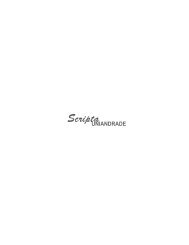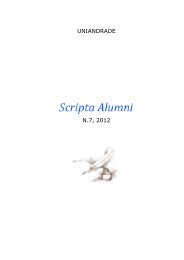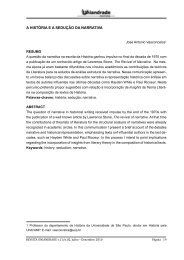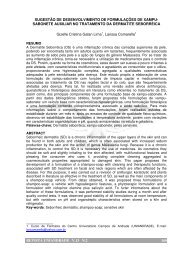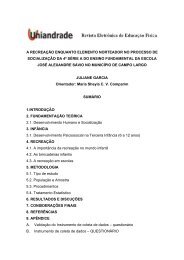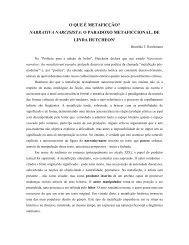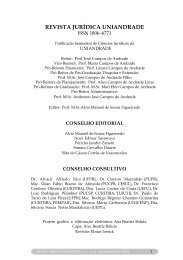Scripta 9_2_link_final.pdf - Uniandrade
Scripta 9_2_link_final.pdf - Uniandrade
Scripta 9_2_link_final.pdf - Uniandrade
Create successful ePaper yourself
Turn your PDF publications into a flip-book with our unique Google optimized e-Paper software.
The excerpt starts from van Ruijven’s obsession with Griet expressed<br />
in the description of The Girl with a Wine Glass. During the negotiation of<br />
Vermeer’s next commission, The Concert, it is agreed that Griet will be<br />
portrayed alone, and not beside van Ruijven, in order to avoid pregnant<br />
Catharina’s jealousy. Griet, though relieved and excited, is aware of the<br />
drawbacks her proximity to Vermeer might bring her.<br />
According to the novel, they start the project on the first day of the<br />
year. Vermeer had already laid the first coat of paint on the canvas, no<br />
“reddish marks,” “false colors,” or even the luminous spots as usual. The<br />
canvas is an empty “yellowish white” (CHEVALIER, 1999, p. 177). Vermeer<br />
asks Griet to read a letter. She considers telling him that the paper is blank,<br />
but chooses to stay quiet. He suggests a book, but concludes that the problem<br />
is in her clothes. She suggests that he paint her as a maid but he refuses:<br />
“What do you want, sir?” I asked, sitting. I was puzzled – we never sat<br />
together. I shivered, although I was not cold.<br />
“Don’t talk.” He opened a shutter so that the light fell directly on my face.<br />
“Look out of the window.” He sat down in his chair by the easel.<br />
I gazed at the New Church tower and swallowed. I could feel my jaw<br />
tightening and my eyes widening.<br />
“Now look at me.” (CHEVALIER, 1999, p. 168-69)<br />
Griet turns her head over her shoulder to face the painter. He asks<br />
her to sit still. She realizes that she is actually being painted by Vermeer.<br />
Only a month later did they continue the modeling. After much negotiation<br />
over the composition of the painting, the master states that he “will paint<br />
[her] as [he] first saw [her], Griet. Just [her]” (CHEVALIER, 1999, p. 179-80).<br />
The painter and the model negotiate the composition of the portrait:<br />
the clothes, the blue and yellow turban instead of the traditional maid’s cap,<br />
the body turned towards the window, the gaze of her wide open eyes, the<br />
glossy lips, and, <strong>final</strong>ly, the pearl earring. The painter worries in particular<br />
about the way the light is reflected on the model’s face. Griet, the fictional<br />
model, was highly aware of it the whole time; she knows that what really<br />
matters to him is the <strong>final</strong> result as requested by his patron. The girl is<br />
important only as his muse and not as a woman. While she does not fight<br />
her feelings towards the painter, Griet follows the natural course of her life<br />
outside of the studio, as evidenced in the excerpt below:<br />
<strong>Scripta</strong> <strong>Uniandrade</strong>, v. 9, n. 2, jul.-dez. 2011 21





